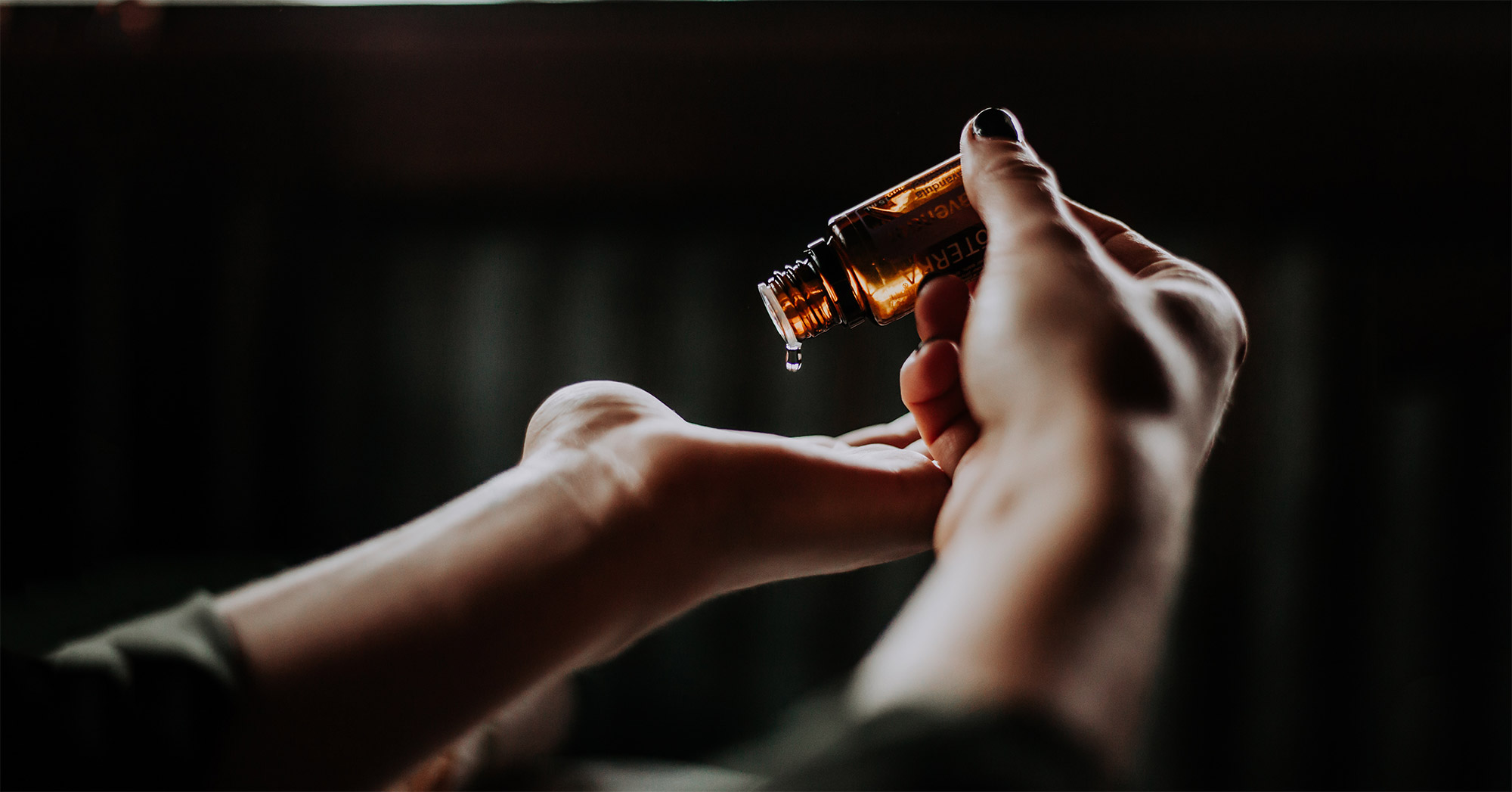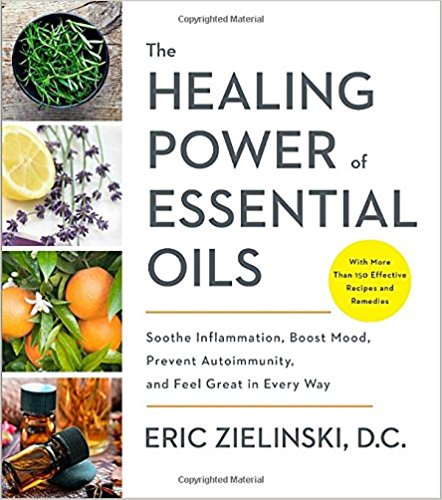Ridding Your Body of Yeast: 6 Antifungal Essential Oils for Killing Candida
BY DR. ERIC ZIELINSKI
 essential oils have been used for millennia for their health, healing and spiritually activating properties. photo: christin hume
essential oils have been used for millennia for their health, healing and spiritually activating properties. photo: christin hume
Candida infections (candidiasis) can have three different presentations.
+ Oropharyngeal candidiasis: Oral yeast infection, or “thrush”
+ Vaginal candidiasis: A vaginal yeast infection
+ Invasive candidiasis: A systemic infection where Candida species enter the bloodstream
It’s important to keep in mind that not all women present candida overgrowth in the same way. Women typically don’t go to their doctor unless they get a vaginal yeast infection, which puts them at risk of developing a systemic problem. If you suffer from a combination of the symptoms below, you may have a candida infection:
+ Brain fog
+ Chronic fatigue
+ Foul body odor
+ Insomnia
+ Low libido
+ Sugar cravings
+ Seasonal allergies
Top Six Essential Oils for Candida
It’s important to point out that most of the essential oil recommendations out there for candida focus on treating vaginal infections or thrush, not invasive candidiasis. This is not to say that essential oil protocols are nonexistent for systemic candida overgrowth, but in my opinion you will be better served if you use essential oils in conjunction with significant dietary changes as your first line of defense. This is particularly true if you’re trying to treat a vaginal yeast infection or oral thrush.
I have seen some dramatic results when the following six essential oils for candida are used to treat overgrowth.
1. Tea Tree
By far, the go-to antifungal oil is tea tree. This oil has a long history as a skin treatment and air-purifying agent, and has been used with great success to treat fungal infections. Thus, tea tree oil for yeast infections is very effective.
Application: Douche up to twice a day to treat a vaginal yeast infection using the following protocol. Similarly, oil pulling with lavender and tea tree can help oral thrush.
![]() Conscious Lifestyle Recommends:
Conscious Lifestyle Recommends:
Plant Therapy Organic Tea Tree Oil
This therapeutic grade organic essential oil is a powerful natural antifungal with many uses. Ultra-pure and ideal for yeast infection, thrush and more.
Candida Douche
Supplies
+ 2 drops lavender essential oil
+ 2 drops tea tree essential oil
+ 1 teaspoon raw honey
+ ½ cup warm distilled water
+ Small glass bowl
+ Douche bag (which you can find at most drugstores) or squeeze bottle
Instructions
+ Mix the essential oils and honey in a glass bowl.
+ Add the water and stir until the honey dissolves.
+ Fill a douche bag with the solution.
+ Sitting on the toilet or squatting in your shower, rinse the vaginal cavity using the douche bag or squeeze bottle.
+ Immediately afterward, wash the vulva with mild soap and water in the shower.
+ Douche once or twice a day for up to two weeks at a time.
Note: Alternatively, you can try the pessary (vaginal suppository) or tampon approach if you stick with the gentler essential oils for yeast infections. Do not use thyme, peppermint, lemongrass, or the other more caustic oils (i.e., “hot” oils like cinnamon, clove, and oregano that cause a burning sensation), or you could cause serious discomfort!
2. Thyme
Broad-spectrum antibiotics and antifungals have failed to stop the epidemic, so researchers are investigating natural broad-spectrum alternatives, including essential oils for candida. A study out of Poland discovered that both tea tree and thyme oils have the uncanny ability to change the morphology and metabolism of yeast enzymes, suggesting that these essential oils can significantly impact Candida albicans pathogenicity and that candida cannot become resistant to these oils.
Application: Make a 2% body oil dilution with thyme and coconut oil and apply over your abdomen to treat systemic candida overgrowth. Not safe for vaginal application.
![]() Conscious Lifestyle Recommends:
Conscious Lifestyle Recommends:
Plant Therapy Organic Thyme Oil
This therapeutic grade organic essential oil is a powerful natural yeast killer with many uses and that is ideal as an alternative to harmful antibiotics.
3. Peppermint
In 2010, one of the most exhaustive studies to date evaluated how thirty different essential oils for Candida albicans inhibited the growth of the bacteria in vitro. Of those tested, twelve were found to be ineffective. Eighteen were found to be effective; of these, eucalyptus and peppermint oils stood out. At concentrations as low as 0.15%, both showed significant fungicidal properties.
Application: Try oil pulling with one drop of peppermint to cleanse the mouth of oral thrush. Not safe for vaginal application.
![]() Conscious Lifestyle Recommends:
Conscious Lifestyle Recommends:
Plant Therapy Organic Peppermint Oil
This therapeutic grade organic oil is both refreshing, rejuvenating and a powerful natural treatment for candida and especially thrush of the mouth that will leave you with naturally fresh breath.
4. Geranium
Specifically testing how geranium helped mice with vaginal candidiasis, researchers discovered that the oil had a minimal effect when applied alone. However, when used in combination with vaginal washing, the infection decreased significantly.
Application: After showering, massage a 1% body oil dilution of geranium oil mixed with a carrier over the genital region to help prevent yeast infections. Coconut and evening primrose oils are the carrier oils of choice.
![]() Conscious Lifestyle Recommends:
Conscious Lifestyle Recommends:
Plant Therapy Organic Geranium Oil
This therapeutic grade Egyptian organic geranium oil is safe for vaginal use (when diluted) and ultra-pure for sensitive areas of skin.
5. Lemon
Truly a jack-of-all-trades, lemon has performed well against drug-resistant strains of a number of bacteria and fungi, including MRSA and candida. Additionally, multiple commercial lemon oils have been shown to contain a broad-spectrum ability, killing a variety of fungal strains, including C. albicans, C. tropicalis, and C. glabrata. Not all lemon oils are equal in treating candida symptoms, however. Be sure to use those that are rich in monoterpenoids.
The key takeaway is this: Limonene—a monocyclic terpene—is the main ingredient in most lemon essential oils on the market. However, the anti-fungal activity depends on the content of oxygenated monoterpenes—the higher the content, the better the fungicidal effects that were observed. If you want to battle candida, try to get a chemical analysis of the brand of lemon oil before buying to be sure it contains these constituents. You can usually find this information on the oil manufacturer’s website.
Application: As with lavender, try incorporating lemon essential oil into your culinary creations—it’s delicious when stirred into olive oil that you drizzle on salad, for example, mixed into yogurt, or added to guacamole—for an extra antifungal punch. A little goes a long way, so start with one drop and add more to taste.
![]() Conscious Lifestyle Recommends:
Conscious Lifestyle Recommends:
Plant Therapy Organic Lemon Oil
This delicious but still highly therapeutic organic essential oil is a broad spectrum natural antifungal that is useful against many strains of candida.
6. Clove
Rich in eugenol—a chemical component of plants with antiseptic properties—clove oil is a superhero at killing microorganisms. Research has shown that its power against candida strains is so potent that it can reduce the fungi to near zero levels, including fluconazole-resistant strains! Before you apply it topically over sensitive areas of your body, however, take great caution and be sure to dilute it properly. I recommend starting at a 1% dilution and working your way up as long as no irritation occurs. Clove is a powerful essential oil for candida, and in general, so take note that it can seriously aggravate your skin.
![]() Conscious Lifestyle Recommends:
Conscious Lifestyle Recommends:
Plant Therapy Organic Clove Oil
This extremely potent oil is a powerful treatment even for antifungal-resistant strains of candida that can be taken internally and used on the skin when properly diluted.
Application: Try combating candida internally with these candida capsules.
Candida Capsules
Makes 1 application
Supplies
+ 2 drops clove essential oil
+ 2 drops thyme essential oil
+ Organic extra-virgin olive oil, grapeseed oil, or unrefined coconut oil (melted)
+ Pipette
+ Size 00 capsule (time-release capsules are preferable)
Instructions
+ Using a pipette, drop the essential oils into the narrower, bottom half of the capsule.
+ Fill the remaining space in the capsule with the carrier oil of your choice.
+ Fit the wider, top half of the capsule over the bottom half and secure snugly.
+ Swallow the capsule immediately with water on an empty stomach.
+ Take once or twice daily for fourteen days.
Note: Do not premake capsules and store for future use because you do not want them to leach or erode.
Additional Essential Oils for Candida
Keep in mind that as you branch out and expand your medicine cabinet to treat candida, certain oils are inherently safer and more effective than others. For instance, oils rich in oxides have a tendency to irritate already sensitive vaginal tissue. This would include oils rich in both 1,4 and 1,8-cineole, so use caution with the following oils:
+ Bay laurel
+ Cajuput
+ Cardamom
+ Eucalyptus (globulus and radiata)
+ Galangal
+ Ho leaf
+ Myrtle
+ Niaouli
+ Rosemary (1,8-cineol ct.)
+ Sage
+ Saro
+ Spike lavender
Alternatively, these essential oils for candida that contain the following alcohols are much gentler:
+ Linalool—clary sage, lavender, lavandin, and ylang ylang
+ Borneol—lavandin, lavender, and rosemary
+ Geraniol—palmarosa, thyme, and Melissa
+ Citronellol—rose, geranium, citronella, and Melissa
+ Menthol—peppermint
As you can see from this exhaustive list of essential oil uses and applications, you have options to treat candida naturally. With that said, if you’re on the SAD (Standard American Diet), are on recurring cycles of antibiotics, or are dealing with unresolved chronic stress in your life—all common triggers of candida—then using essential oils for yeast infections is like taking one step forward and two steps back.
As with all of the conditions discussed in this book, a completely holistic approach is a must if you want to fully resolve a candida infection. Sure, essential oils can help, but they are only one piece of the (organic, gluten-free, naturally sweetened) pie!
 Excerpted from The Healing Power of Essential Oils. Copyright © 2018 by Eric Zielinski, D.C. Published by Harmony Books, an imprint of Crown Publishing Group, a division of Penguin Random House LLC.
Excerpted from The Healing Power of Essential Oils. Copyright © 2018 by Eric Zielinski, D.C. Published by Harmony Books, an imprint of Crown Publishing Group, a division of Penguin Random House LLC.
About The Author
Dr. Eric Zielinski is on a mission to help people experience the abundant life. Formally trained as a public health researcher and aromatherapist, Dr. Z is the founder of the Essential Oils Revolution summits and Essential Oils for Abundant Living Masterclass that have helped more than 550,000 people across the globe use essential oils safely and effectively. An accomplished researcher with several publications and conference proceedings, Dr. Z currently sits as peer-reviewer for multiple journals. He lives in Atlanta with his wife and four children. Learn more at: drericz.com







